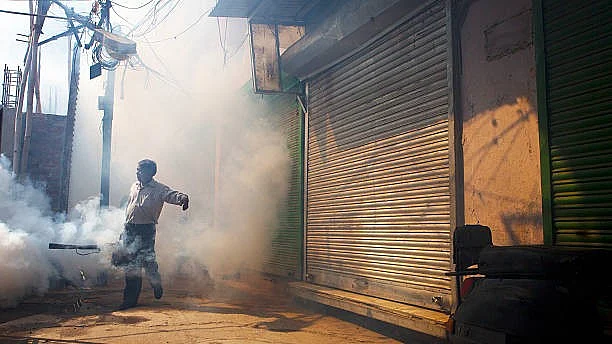The national capital is witnessing a surge in the number of cases of dengue, with December recording more than 250 cases of the vector borne disease. Delhi has crossed over 4,000 cases for the year, with the tally standing at 3,857 till 9 December, and then a sudden spike.
Delhi and many parts of North India, along with the coastal regions have seen vector borne disease like dengue, chikungunya and malaria becoming endemic over the past few decades.
Multiple interventions, public awareness drives and enhanced health infrastructure have all played a role in trying to ensure its control. But these mitigation strategies aside, a critical underpinning of the causality is the contribution of climate change.
Uneven Pattern Of Prevalence
A study of the official number of dengue cases in India by the Union Ministry for Health & Family Welfare’s nodal agency, the National Center for Vector Borne Diseases Control agency (NVBDCP), makes for indicative reading. Since 2017, the number of cases of dengue have shown an uneven pattern of prevalence.
Discounting for the gaps in surveillance reporting and owing to the lockdown effect, 2020 shows a marked reduction in numbers.
However, 2021 witnessed the highest number of cases since 2017 and the data till 31 October 2022 shows that this year will broadly match the 2021 numbers.
Within the states reporting their respective numbers, a telling pattern is revealed from hill states of Himachal Pradesh, Uttarakhand and Jammu & Kashmir. Compared to 2017, all these states have reported a staggeringly high number of cases of dengue till October of this year.
Multiple factors can be attributed to this increase which include dengue being made a notifiable disease by the Government of India in October 2021, thereby enforcing its reporting through a mandate under the Epidemic Diseases Act 1897.
Additionally, better surveillance and reporting mechanisms can all be logically assumed to contribute to this higher reporting.
However, much of the data for the aforementioned states and for others does not give the full picture.
Dengue Spike in Monsoons
Outbreaks of dengue and similar vector-borne diseases like chikungunya were hitherto associated with the monsoons and rain patterns which led to increased breeding and prevalence of conducive conditions for the vector.
Similarly, enabling this phenomenon were heat and humidity which provided fertile ground for the transmitting agent, the Aedes aegypti mosquito.
Changing weather patterns, most notably a shift in patterns and intensity of rains and higher temperatures well into the traditional winter months in north India, have meant that the climatic suitability of dengue has increased.
As per 2022 report by The Lancet Countdown on health and climate change, the climatic suitability for the transmission of dengue increased by 11.5 percent for Aedes aegypti and 12 percent for Aedes albopictus from 1951–60 to 2012–21 globally.
The report further attributes climate change, urbanisation and increased movement of people and goods as contributory factors in the shift. Most notable among the attributes within the climate change milieu has been rising temperatures.
Reports by the USAID and studies published by the journal Nature, have highlighted the impact of rising temperatures on vector borne diseases across the world.
Layer this data with the intense heat waves witnessed in North India during the summer, and the warmer winters, the reason for the current dengue outbreak becomes self-evident.
What Can The Government Do?
The expanding geographic spread, increased climatic suitability owing to warmer temperatures and the rise in reported numbers should all be clarion calls for a concerted response. Steps to increase surveillance and provide regulatory teeth on reporting are important to help assess the actual prevalence and change in patterns.
The 2021 notification helps in this regard and therefore the 2022 disease numbers should serve as the factual current state.
However, Governments will need to get more granular to better assess the changing patterns of disease and consequentially establish causation.
Steps towards mitigation, which include increasing the number of labs testing for vector borne disease and strengthening response institutions like health centers and hospitals will help alleviate the impact of the disease.
But beyond that, the Government will need to create better forecasting tools that can act as actionable intelligence for health services to respond to.
Retrospective data collection is critical, but real-time information can help build healthcare resiliency against these changing disease vectors.
Health systems will need to gear up towards a multi-hazard approach.
Sequential disease preparedness, where diseases of the summer follow those of the winter seem to be a thing of the past. With persistent air pollution, warmer temperatures, more intense cold-heat waves and erratic rains, our systemic response will need to have adequate resources to manage all of these concurrently.
Therefore, the need for better data, predictive capabilities, and a risk mitigation and response for each unit of the health system has become a necessity.
Shift In Mindset: Need Of the Hour
However, the real shift needs to be in mindsets in our approach towards climate change and its impact on human health.
The climate crisis is many ways a health crisis. Every aspect of our changing climate will, and is, impacting human health. This paradigm shift needs adequate amplification from governments, policymakers, doctors, and civil society.
Dengue is only an indication of a changing pattern of diseases that are attributable to climate change.
The real sting lies in that reality.
(Dr Karan Thakur is a healthcare administrator and heads sustainability initiatives at Apollo Hospitals. He tweets @karanthakur. This is an opinion piece and the views expressed above are the author’s own. The Quint neither endorses nor is responsible for the same.)

